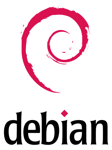Debian 7 "Wheezy" released
 The release of Debian 7.0, also known as Wheezy, has taken place – the community-driven and built Linux distribution's most visible change is a new updated look with GNOME 3.4 and the GNOME shell as the default desktop. But there are important changes behind the scenes which will make Wheezy easier to work with and simpler to use to create private clouds. In all, the developers have worked for just over two years, since the release of Debian 6 "Squeeze", to produce the new stable version of the distribution.
The release of Debian 7.0, also known as Wheezy, has taken place – the community-driven and built Linux distribution's most visible change is a new updated look with GNOME 3.4 and the GNOME shell as the default desktop. But there are important changes behind the scenes which will make Wheezy easier to work with and simpler to use to create private clouds. In all, the developers have worked for just over two years, since the release of Debian 6 "Squeeze", to produce the new stable version of the distribution.
Debian stable releases are built on proven software so, for example, the Linux Kernel is based on Linux version 3.2, release in January 2012, and version 3.6.6 of the Samba file sharing is included rather than the latest Samba 4. This conservative nature serves Debian well; users who wish to use more modern packages can find them in the unstable/testing branches of the project. Other software versions bundled include X.Org 7.7, LibreOffice 3.5, Bind 9.8, GCC 4.7, MySQL 5.5, PostgreSQL 9.1, and version 2.7.3 and 3.2.3 of Python.
Other packages include IceWeasel 10, an unbranded version of Firefox which is currently at version 20, and Icedove 10. The OpenJDK versions 6b27 and 7u3 are also older, and The H recommends that users make sure Java is not enabled in their browser to avoid exposure to the various security issues that have plagued the Java browser plugin this year.
As usual, there is also the text mode and graphical installer available, but one innovation for Debian 7.0 is the addition of a speech-guided installation system intended to help the visually impaired navigate through the process of setting up Debian. This is a complement to the existing support for users with Braille devices and allows users without access to such devices to install Debian. This has, though, been created as a simple text-to-speech overlay on the text-mode installer and some dialogs, such as the list of over 73 languages available in the installer, do take a while to listen through; a dozen of those languages are available for speech-guided installation.
Important changes have taken place in how Wheezy manages multiple architectures. The new multiarch support will let users install packages from multiple architectures on the same machine, so for example, 32-bit and 64-bit packages can be installed and the system will automatically and correctly resolve dependencies. A variety of architectures are supported on this release of Debian: 32-bit PC IA32 (i386), 64-bit PC X86-64 (amd64), PowerPC (powerpc), Oracle SPARC (sparc), MIPS (bigendian mips and little endian mipsel), Intel Itanium (ia64), IBM S/390 (31-bit s390 and 64-bit s390x) and ARM (armel for older hardware and armhf for the hardware floating point in newer hardware).
Wheezy is also being used to help free software developers address the cloud. Various cloud-enabling projects mean that, for example, OpenStack and the Xen Cloud Platform (XCP) are both already packaged for Debian 7. XCP provides the virtualisation and OpenStack can manage that virtualisation to provide a scalable private cloud. XCP also works with CloudStack and OpenNebula.
Debian 7 release notes for all the architectures are available in a range of languages and are recommended reading, along with the installation guides, for users planning to install Wheezy. CD and DVD images are available to download via BitTorrent (the recommended route), jigodo (jigsaw download), and over HTTP or FTP. Debian CD and DVDs should be available in the coming weeks from vendors.
(djwm)
![Kernel Log: Coming in 3.10 (Part 3) [--] Infrastructure](/imgs/43/1/0/4/2/6/7/2/comingin310_4_kicker-4977194bfb0de0d7.png)

![Kernel Log: Coming in 3.10 (Part 3) [--] Infrastructure](/imgs/43/1/0/4/2/3/2/3/comingin310_3_kicker-151cd7b9e9660f05.png)
















